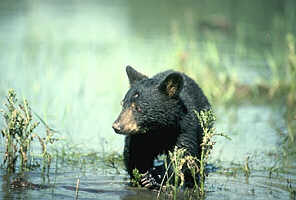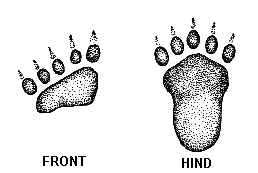
Black Bears
Ursus americanus
Description
- Typical coloration of Black Bears in the west
is black to cinnamon with a white blaze on the chest
and in the east, black. On Gribble Island and the neighbouring
mainland of British Columbia individuals are nearly
white. The snout is tan or grizzled with a straight
or slightly convex profile. Average weight is 200-600
pounds.
Distribution
- Black Bears inhabit heavily forested areas, dense
bush and wooded mountains throughout most of British
Columbia. They tend to wander a great distance, some
male adults having lifetime ranges of 500 to 620 square
miles.
Biology
- 1-5 cubs are born in January to early February generally
every second year. The Black Bear young weigh only one-half
a pound at birth. This uniquely North American bear
is generally nocturnal and solitary. It is classed as
a carnivore although most of its diet consists of vegetation
such as twigs, buds, leaves, nuts, roots, various fruits,
corn and berries. They are also good fisherman and feed
on spawning salmon. Before winter it puts on a great
supply of fat, then holes up for the winter in a sheltered
place. Hunting Black Bears is a popular sport, the meat
is eaten and often the hides are made into rugs.

Tracks
The tracks of this slightly pigeon-toed creature are
characterized by the overlapping of the hind prints
onto those of the front. The heel pad of the rear foot
is long and vaguely resembles that of a human. Five
toes with equally long claws are evenly spaced along
the top of this pad.
Straddle: 43 - 47 cm (17.2 - 18.8 in)
Stride: 45 - 50 cm (18 - 20 in)
Tracks: Front - 15 cm (6 in) long / 14 cm (5.6 in) wide
Tracks: Rear - 25 cm (10 in) long / 15 cm (6 in) wide


